Lijun Wang
Optimal Labeler Assignment and Sampling for Active Learning in the Presence of Imperfect Labels
Dec 14, 2025Abstract:Active Learning (AL) has garnered significant interest across various application domains where labeling training data is costly. AL provides a framework that helps practitioners query informative samples for annotation by oracles (labelers). However, these labels often contain noise due to varying levels of labeler accuracy. Additionally, uncertain samples are more prone to receiving incorrect labels because of their complexity. Learning from imperfectly labeled data leads to an inaccurate classifier. We propose a novel AL framework to construct a robust classification model by minimizing noise levels. Our approach includes an assignment model that optimally assigns query points to labelers, aiming to minimize the maximum possible noise within each cycle. Additionally, we introduce a new sampling method to identify the best query points, reducing the impact of label noise on classifier performance. Our experiments demonstrate that our approach significantly improves classification performance compared to several benchmark methods.
Beyond Classification Accuracy: Neural-MedBench and the Need for Deeper Reasoning Benchmarks
Sep 26, 2025Abstract:Recent advances in vision-language models (VLMs) have achieved remarkable performance on standard medical benchmarks, yet their true clinical reasoning ability remains unclear. Existing datasets predominantly emphasize classification accuracy, creating an evaluation illusion in which models appear proficient while still failing at high-stakes diagnostic reasoning. We introduce Neural-MedBench, a compact yet reasoning-intensive benchmark specifically designed to probe the limits of multimodal clinical reasoning in neurology. Neural-MedBench integrates multi-sequence MRI scans, structured electronic health records, and clinical notes, and encompasses three core task families: differential diagnosis, lesion recognition, and rationale generation. To ensure reliable evaluation, we develop a hybrid scoring pipeline that combines LLM-based graders, clinician validation, and semantic similarity metrics. Through systematic evaluation of state-of-the-art VLMs, including GPT-4o, Claude-4, and MedGemma, we observe a sharp performance drop compared to conventional datasets. Error analysis shows that reasoning failures, rather than perceptual errors, dominate model shortcomings. Our findings highlight the necessity of a Two-Axis Evaluation Framework: breadth-oriented large datasets for statistical generalization, and depth-oriented, compact benchmarks such as Neural-MedBench for reasoning fidelity. We release Neural-MedBench at https://neuromedbench.github.io/ as an open and extensible diagnostic testbed, which guides the expansion of future benchmarks and enables rigorous yet cost-effective assessment of clinically trustworthy AI.
Efficiently Building a Domain-Specific Large Language Model from Scratch: A Case Study of a Classical Chinese Large Language Model
May 17, 2025Abstract:General-purpose large language models demonstrate notable capabilities in language comprehension and generation, achieving results that are comparable to, or even surpass, human performance in many language information processing tasks. Nevertheless, when general models are applied to some specific domains, e.g., Classical Chinese texts, their effectiveness is often unsatisfactory, and fine-tuning open-source foundational models similarly struggles to adequately incorporate domain-specific knowledge. To address this challenge, this study developed a large language model, AI Taiyan, specifically designed for understanding and generating Classical Chinese. Experiments show that with a reasonable model design, data processing, foundational training, and fine-tuning, satisfactory results can be achieved with only 1.8 billion parameters. In key tasks related to Classical Chinese information processing such as punctuation, identification of allusions, explanation of word meanings, and translation between ancient and modern Chinese, this model exhibits a clear advantage over both general-purpose large models and domain-specific traditional models, achieving levels close to or surpassing human baselines. This research provides a reference for the efficient construction of specialized domain-specific large language models. Furthermore, the paper discusses the application of this model in fields such as the collation of ancient texts, dictionary editing, and language research, combined with case studies.
Learning Universal Features for Generalizable Image Forgery Localization
Apr 10, 2025Abstract:In recent years, advanced image editing and generation methods have rapidly evolved, making detecting and locating forged image content increasingly challenging. Most existing image forgery detection methods rely on identifying the edited traces left in the image. However, because the traces of different forgeries are distinct, these methods can identify familiar forgeries included in the training data but struggle to handle unseen ones. In response, we present an approach for Generalizable Image Forgery Localization (GIFL). Once trained, our model can detect both seen and unseen forgeries, providing a more practical and efficient solution to counter false information in the era of generative AI. Our method focuses on learning general features from the pristine content rather than traces of specific forgeries, which are relatively consistent across different types of forgeries and therefore can be used as universal features to locate unseen forgeries. Additionally, as existing image forgery datasets are still dominated by traditional hand-crafted forgeries, we construct a new dataset consisting of images edited by various popular deep generative image editing methods to further encourage research in detecting images manipulated by deep generative models. Extensive experimental results show that the proposed approach outperforms state-of-the-art methods in the detection of unseen forgeries and also demonstrates competitive results for seen forgeries. The code and dataset are available at https://github.com/ZhaoHengrun/GIFL.
Mono2Stereo: A Benchmark and Empirical Study for Stereo Conversion
Mar 28, 2025Abstract:With the rapid proliferation of 3D devices and the shortage of 3D content, stereo conversion is attracting increasing attention. Recent works introduce pretrained Diffusion Models (DMs) into this task. However, due to the scarcity of large-scale training data and comprehensive benchmarks, the optimal methodologies for employing DMs in stereo conversion and the accurate evaluation of stereo effects remain largely unexplored. In this work, we introduce the Mono2Stereo dataset, providing high-quality training data and benchmark to support in-depth exploration of stereo conversion. With this dataset, we conduct an empirical study that yields two primary findings. 1) The differences between the left and right views are subtle, yet existing metrics consider overall pixels, failing to concentrate on regions critical to stereo effects. 2) Mainstream methods adopt either one-stage left-to-right generation or warp-and-inpaint pipeline, facing challenges of degraded stereo effect and image distortion respectively. Based on these findings, we introduce a new evaluation metric, Stereo Intersection-over-Union, which prioritizes disparity and achieves a high correlation with human judgments on stereo effect. Moreover, we propose a strong baseline model, harmonizing the stereo effect and image quality simultaneously, and notably surpassing current mainstream methods. Our code and data will be open-sourced to promote further research in stereo conversion. Our models are available at mono2stereo-bench.github.io.
AVS-Mamba: Exploring Temporal and Multi-modal Mamba for Audio-Visual Segmentation
Jan 14, 2025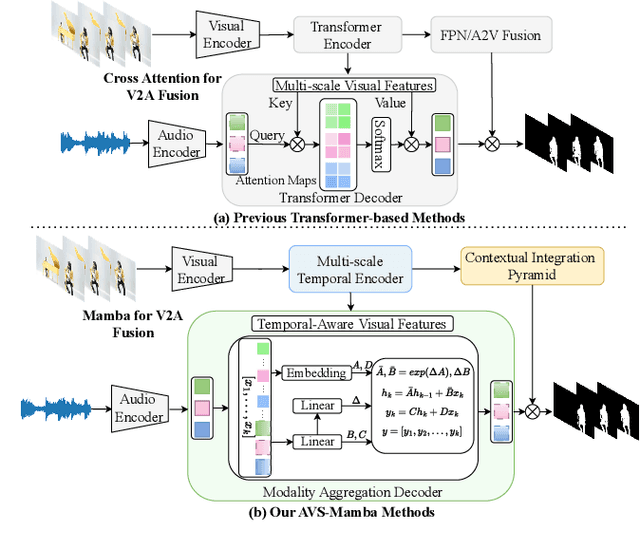

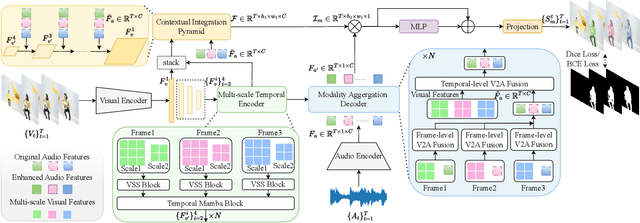
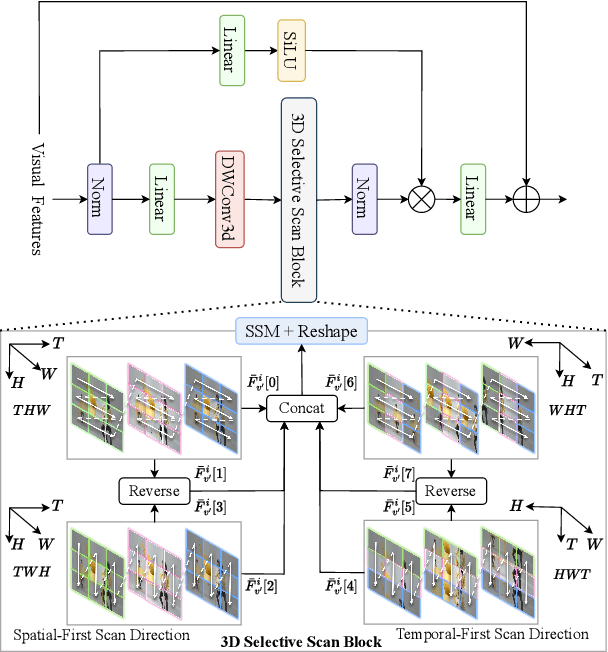
Abstract:The essence of audio-visual segmentation (AVS) lies in locating and delineating sound-emitting objects within a video stream. While Transformer-based methods have shown promise, their handling of long-range dependencies struggles due to quadratic computational costs, presenting a bottleneck in complex scenarios. To overcome this limitation and facilitate complex multi-modal comprehension with linear complexity, we introduce AVS-Mamba, a selective state space model to address the AVS task. Our framework incorporates two key components for video understanding and cross-modal learning: Temporal Mamba Block for sequential video processing and Vision-to-Audio Fusion Block for advanced audio-vision integration. Building on this, we develop the Multi-scale Temporal Encoder, aimed at enhancing the learning of visual features across scales, facilitating the perception of intra- and inter-frame information. To perform multi-modal fusion, we propose the Modality Aggregation Decoder, leveraging the Vision-to-Audio Fusion Block to integrate visual features into audio features across both frame and temporal levels. Further, we adopt the Contextual Integration Pyramid to perform audio-to-vision spatial-temporal context collaboration. Through these innovative contributions, our approach achieves new state-of-the-art results on the AVSBench-object and AVSBench-semantic datasets. Our source code and model weights are available at AVS-Mamba.
OASIS: Open Agent Social Interaction Simulations with One Million Agents
Nov 26, 2024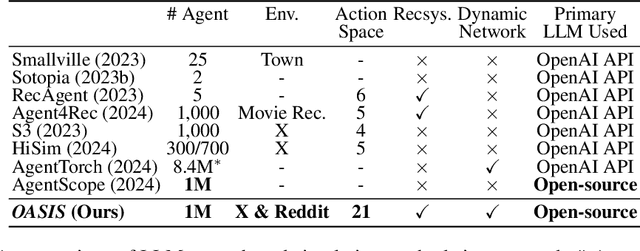
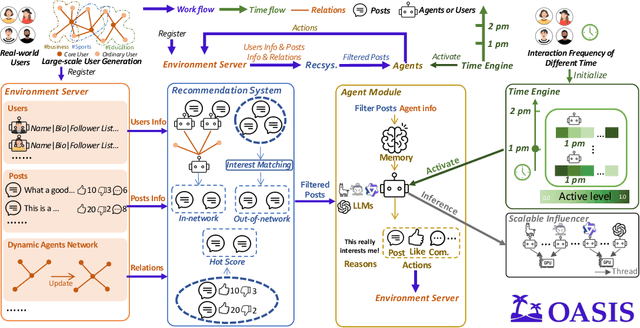

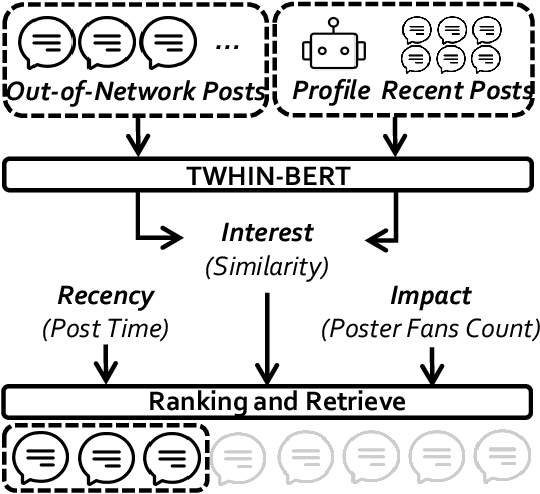
Abstract:There has been a growing interest in enhancing rule-based agent-based models (ABMs) for social media platforms (i.e., X, Reddit) with more realistic large language model (LLM) agents, thereby allowing for a more nuanced study of complex systems. As a result, several LLM-based ABMs have been proposed in the past year. While they hold promise, each simulator is specifically designed to study a particular scenario, making it time-consuming and resource-intensive to explore other phenomena using the same ABM. Additionally, these models simulate only a limited number of agents, whereas real-world social media platforms involve millions of users. To this end, we propose OASIS, a generalizable and scalable social media simulator. OASIS is designed based on real-world social media platforms, incorporating dynamically updated environments (i.e., dynamic social networks and post information), diverse action spaces (i.e., following, commenting), and recommendation systems (i.e., interest-based and hot-score-based). Additionally, OASIS supports large-scale user simulations, capable of modeling up to one million users. With these features, OASIS can be easily extended to different social media platforms to study large-scale group phenomena and behaviors. We replicate various social phenomena, including information spreading, group polarization, and herd effects across X and Reddit platforms. Moreover, we provide observations of social phenomena at different agent group scales. We observe that the larger agent group scale leads to more enhanced group dynamics and more diverse and helpful agents' opinions. These findings demonstrate OASIS's potential as a powerful tool for studying complex systems in digital environments.
OASIS: Open Agents Social Interaction Simulations on One Million Agents
Nov 21, 2024



Abstract:There has been a growing interest in enhancing rule-based agent-based models (ABMs) for social media platforms (i.e., X, Reddit) with more realistic large language model (LLM) agents, thereby allowing for a more nuanced study of complex systems. As a result, several LLM-based ABMs have been proposed in the past year. While they hold promise, each simulator is specifically designed to study a particular scenario, making it time-consuming and resource-intensive to explore other phenomena using the same ABM. Additionally, these models simulate only a limited number of agents, whereas real-world social media platforms involve millions of users. To this end, we propose OASIS, a generalizable and scalable social media simulator. OASIS is designed based on real-world social media platforms, incorporating dynamically updated environments (i.e., dynamic social networks and post information), diverse action spaces (i.e., following, commenting), and recommendation systems (i.e., interest-based and hot-score-based). Additionally, OASIS supports large-scale user simulations, capable of modeling up to one million users. With these features, OASIS can be easily extended to different social media platforms to study large-scale group phenomena and behaviors. We replicate various social phenomena, including information spreading, group polarization, and herd effects across X and Reddit platforms. Moreover, we provide observations of social phenomena at different agent group scales. We observe that the larger agent group scale leads to more enhanced group dynamics and more diverse and helpful agents' opinions. These findings demonstrate OASIS's potential as a powerful tool for studying complex systems in digital environments.
GLDesigner: Leveraging Multi-Modal LLMs as Designer for Enhanced Aesthetic Text Glyph Layouts
Nov 18, 2024

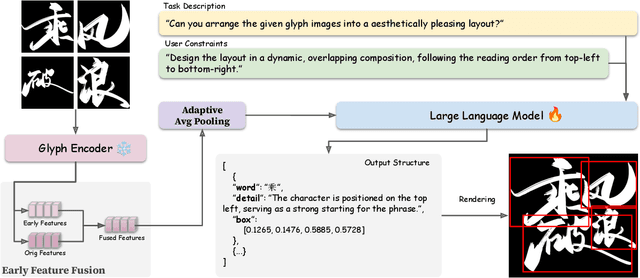

Abstract:Text logo design heavily relies on the creativity and expertise of professional designers, in which arranging element layouts is one of the most important procedures. However, few attention has been paid to this specific task which needs to take precise textural details and user constraints into consideration, but only on the broader tasks such as document/poster layout generation. In this paper, we propose a VLM-based framework that generates content-aware text logo layouts by integrating multi-modal inputs with user constraints, supporting a more flexible and stable layout design in real-world applications. We introduce two model techniques to reduce the computation for processing multiple glyph images simultaneously, while does not face performance degradation. To support instruction-tuning of out model, we construct two extensive text logo datasets, which are 5x more larger than the existing public dataset. Except for the geometric annotations (e.g. text masks and character recognition), we also compliment with comprehensive layout descriptions in natural language format, for more effective training to have reasoning ability when dealing with complex layouts and custom user constraints. Experimental studies demonstrate the effectiveness of our proposed model and datasets, when comparing with previous methods in various benchmarks to evaluate geometric aesthetics and human preferences. The code and datasets will be publicly available.
AD-H: Autonomous Driving with Hierarchical Agents
Jun 05, 2024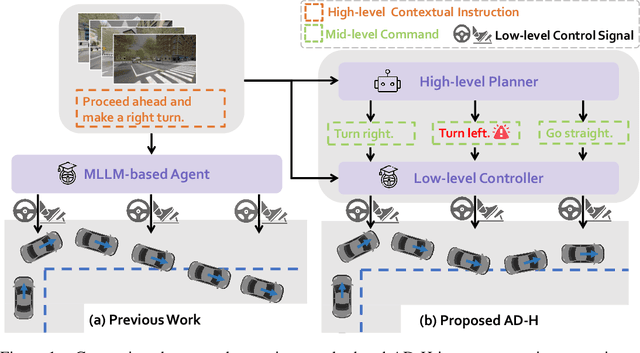

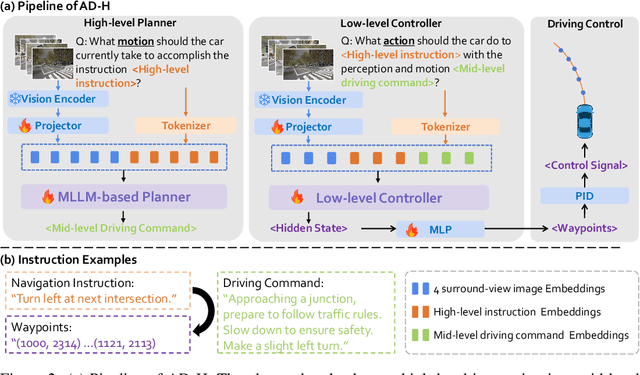
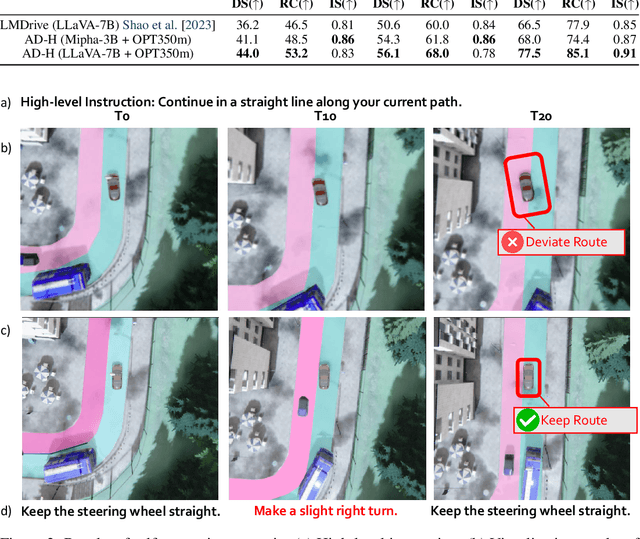
Abstract:Due to the impressive capabilities of multimodal large language models (MLLMs), recent works have focused on employing MLLM-based agents for autonomous driving in large-scale and dynamic environments. However, prevalent approaches often directly translate high-level instructions into low-level vehicle control signals, which deviates from the inherent language generation paradigm of MLLMs and fails to fully harness their emergent powers. As a result, the generalizability of these methods is highly restricted by autonomous driving datasets used during fine-tuning. To tackle this challenge, we propose to connect high-level instructions and low-level control signals with mid-level language-driven commands, which are more fine-grained than high-level instructions but more universal and explainable than control signals, and thus can effectively bridge the gap in between. We implement this idea through a hierarchical multi-agent driving system named AD-H, including a MLLM planner for high-level reasoning and a lightweight controller for low-level execution. The hierarchical design liberates the MLLM from low-level control signal decoding and therefore fully releases their emergent capability in high-level perception, reasoning, and planning. We build a new dataset with action hierarchy annotations. Comprehensive closed-loop evaluations demonstrate several key advantages of our proposed AD-H system. First, AD-H can notably outperform state-of-the-art methods in achieving exceptional driving performance, even exhibiting self-correction capabilities during vehicle operation, a scenario not encountered in the training dataset. Second, AD-H demonstrates superior generalization under long-horizon instructions and novel environmental conditions, significantly surpassing current state-of-the-art methods. We will make our data and code publicly accessible at https://github.com/zhangzaibin/AD-H
 Add to Chrome
Add to Chrome Add to Firefox
Add to Firefox Add to Edge
Add to Edge